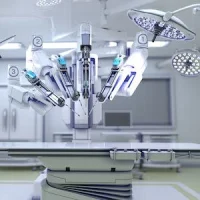Scientists at the Hebrew University of Jerusalem (Israel) have developed a new imaging technique to reduce the risk of patients sustaining bile duct injury during gallbladder surgery. The new technique was developed through the BioDesign: Medical Innovation programme, a collaboration between the university and Hadassah Medical Center.
Laparoscopic cholecystectomy is a minimally invasive procedure for gallbladder removal. Although the procedure has a very high success rate, 1 in 200 patients will sustain serious bile duct injury, mainly due to misidentification of the biliary anatomy. With 800,000 procedures performed in the United States each year, that means in the U.S. alone 4,000 patients will be seriously injured.
Current attempts to simplify bile duct identification rely on the intravascular injection of contrast agents and fluorescent dyes. However, these methods significantly increase the duration and complexity of the laparoscopic procedure. For this reason, these technologies are seldom used. Members of the BioDesign programme set out to develop a solution to this problem.
The laparoscopic procedure is simple and fast, hence surgeons are reluctant to make it complex by adding new imaging modalities, according to Dr. Muhammad Adileh, who led the BioDesign team. “We had to find a solution that wouldn’t complicate things by changing the procedure or increasing operation time,” he explained.
Partnering with Prof. Yaakov Nahmias, director of the Hebrew University’s Alexander Grass Center for Bioengineering, the team identified a unique spectrum of bile acid absorption. “We found that red light in the visible range is predominantly absorbed by bile acids in the biliary tree,” Prof. Nahmias said. Through animal experiments, the team was able to identify bile ducts just by switching the colour and direction of incident light.
This significant discovery would allow surgeons to perform the simple laparoscopic procedure and identify bile ducts with a single flip of a button, Prof. Nahmias noted.
The project, called CholeVision, will culminate in a dedicated laparoscopic tool that would allow surgeons to avoid bile duct injuries and their devastating consequences.
BioDesign: Medical Innovation is a multidisciplinary, team-based approach to medical innovation. Sponsored by Boston Scientific and the Terumo Medical Corporation, the programme takes outstanding medical fellows, bioengineering and business graduate students, and tutors them in the science and practice of bringing a medical innovation to the market.
Source and video/image credit: Hebrew University of Jerusalem
Laparoscopic cholecystectomy is a minimally invasive procedure for gallbladder removal. Although the procedure has a very high success rate, 1 in 200 patients will sustain serious bile duct injury, mainly due to misidentification of the biliary anatomy. With 800,000 procedures performed in the United States each year, that means in the U.S. alone 4,000 patients will be seriously injured.
Current attempts to simplify bile duct identification rely on the intravascular injection of contrast agents and fluorescent dyes. However, these methods significantly increase the duration and complexity of the laparoscopic procedure. For this reason, these technologies are seldom used. Members of the BioDesign programme set out to develop a solution to this problem.
The laparoscopic procedure is simple and fast, hence surgeons are reluctant to make it complex by adding new imaging modalities, according to Dr. Muhammad Adileh, who led the BioDesign team. “We had to find a solution that wouldn’t complicate things by changing the procedure or increasing operation time,” he explained.
Partnering with Prof. Yaakov Nahmias, director of the Hebrew University’s Alexander Grass Center for Bioengineering, the team identified a unique spectrum of bile acid absorption. “We found that red light in the visible range is predominantly absorbed by bile acids in the biliary tree,” Prof. Nahmias said. Through animal experiments, the team was able to identify bile ducts just by switching the colour and direction of incident light.
This significant discovery would allow surgeons to perform the simple laparoscopic procedure and identify bile ducts with a single flip of a button, Prof. Nahmias noted.
The project, called CholeVision, will culminate in a dedicated laparoscopic tool that would allow surgeons to avoid bile duct injuries and their devastating consequences.
BioDesign: Medical Innovation is a multidisciplinary, team-based approach to medical innovation. Sponsored by Boston Scientific and the Terumo Medical Corporation, the programme takes outstanding medical fellows, bioengineering and business graduate students, and tutors them in the science and practice of bringing a medical innovation to the market.
Source and video/image credit: Hebrew University of Jerusalem
Latest Articles
healthmanagement, surgery, imaging, gallbladder, laparoscopy, medical innovations
Scientists at the Hebrew University of Jerusalem (Israel) have developed a new imaging technique to reduce the risk of patients sustaining bile duct injury during gallbladder surgery.


![Tuberculosis Diagnostics: The Promise of [18F]FDT PET Imaging Tuberculosis Diagnostics: The Promise of [18F]FDT PET Imaging](https://res.cloudinary.com/healthmanagement-org/image/upload/c_thumb,f_auto,fl_lossy,h_184,q_90,w_500/v1721132076/cw/00127782_cw_image_wi_88cc5f34b1423cec414436d2748b40ce.webp)







